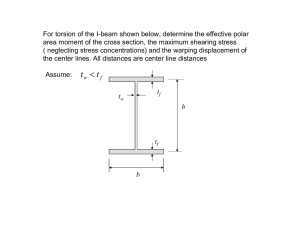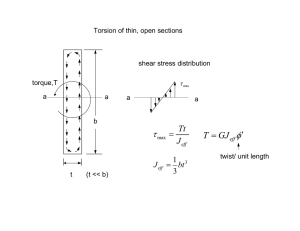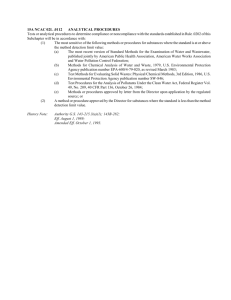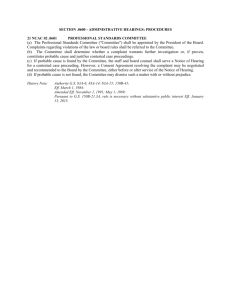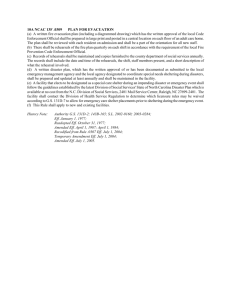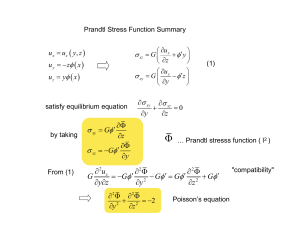( ) ds dz
advertisement
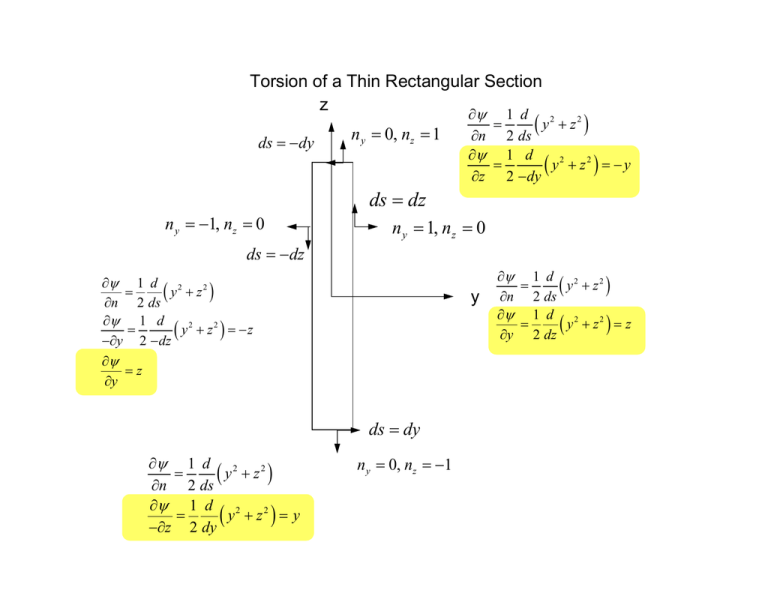
Torsion of a Thin Rectangular Section z ds = − dy n y = 0, nz = 1 ∂ψ 1 d 2 = y + z2 ) ( ∂n 2 ds ∂ψ 1 d = y2 + z2 ) = − y ( ∂z 2 − dy ds = dz n y = −1, nz = 0 n y = 1, nz = 0 ds = − dz ∂ψ 1 d 2 = y + z2 ) ( ∂n 2 ds ∂ψ 1 d = y2 + z2 ) = −z ( −∂y 2 − dz ∂ψ =z ∂y y ds = dy ∂ψ 1 d 2 y + z2 ) = ( ∂n 2 ds ∂ψ 1 d 2 y + z2 ) = y = ( −∂z 2 dy n y = 0, nz = −1 ∂ψ 1 d 2 y + z2 ) = ( ∂n 2 ds ∂ψ 1 d 2 y + z2 ) = z = ( ∂y 2 dz z ∂ 2ψ ∂ 2ψ ∇ψ = 2 + 2 =0 ∂y ∂z 2 ψ = yz ∂ψ =z ∂y ∂ψ =z ∂y y t ⎛ ∂ψ ⎞ − z⎟ ⎝ ∂y ⎠ ⎛ ∂ψ ⎞ + y⎟ σ xz = Gφ ′ ⎜ ⎝ ∂z ⎠ σ xy = Gφ ′ ⎜ σ xz = 2Gφ ′ y = T = GJ eff φ ′ 2Ty J eff σ xy = 0 2 2 ⎧⎪⎛ ∂ψ ⎞ ⎛ ∂ψ ⎞ ⎫⎪ J eff = ∫ ⎨⎜ z − ⎟ +⎜ y+ ⎟ ⎬ dA ∂y ⎠ ⎝ ∂z ⎠ ⎪⎭ A⎪ ⎩⎝ bt 3 2 = 4∫ y dA = 4 I z = bt 3 J eff = 3 A 3 σ xz τ max Tt = J eff Out of plane warping >> z= linspace(-5,5, 20); >> y =linspace(-0.5,0.5,10); >> [zz, yy] = meshgrid(z,y); >> ux=zz.*yy; >> mesh(zz,yy,ux) >> axis equal >> view (50,20) no warping no warping u x = φ ′ yz The results we obtained for the torsion of a thin rectangle can also be used, with some qualifications, for other thin open sections such as shown in the figure below For example, the effective area moments for the cross sections shown can be calculated as 1 (a ) J eff = bt 3 3 1 1 (b) Jeff = b1t13 + b2 t23 3 3 1 1 1 (c ) J eff = b1 t13 + b2 t23 + b3 t33 3 3 3 Also, the maximum shear stress formula can still be applied as τ max where Ttmax = Jeff t max is the largest thickness of the cross section. However, this maximum shear stress occurs on the outer edges of the thickest section and does not account for the stress concentrations that occur at reentrant corners such as those marked with a C in Fig. 1. At such locations, the stresses depend on the local radius of curvature of the corner and may be considerably larger than the value predicted from Eq. (1). Such stress concentrations can be taken into account by finding either numerically or experimentally a stress concentration factor, K, for each re-entrant corner and then examining all high stress points and choosing the one with the highest stress, i.e. τ max ⎡ Tt ⎤ = ⎢K ⎥ J ⎣ eff ⎦ max t Stress Concentrations open section r τ max τ 3 2.5 t τ max K= τ 2 r 1.5 τ max τ 1 closed section 0.5 0 0.5 r /t 1.0 1.5 Centerline warping of thin open sections u x = −φ ′ω ω = ∫ r⊥ ds + ω0 sectorial area function ds r⊥ dΩ T O d ω = r⊥ ds 1 r⊥ ds 2 ω = 2 ∫ d Ω = 2Ω + ω0 center of twist dΩ = ω+ since we are taking T as positive counterclockwise, ω is positive if the area is swept out in a counterclockwise manner ω− To locate the center of twist, O, we must have ∫ yω dA = 0 ∫ zω dA = 0 To fix ω0 y and z are measured from the centroid of the cross section we can specify ∫ ω dA = o An ω satisfying all three of the above conditions is called a principal sectorial area function, ωp u x = −φ ′ ω p
